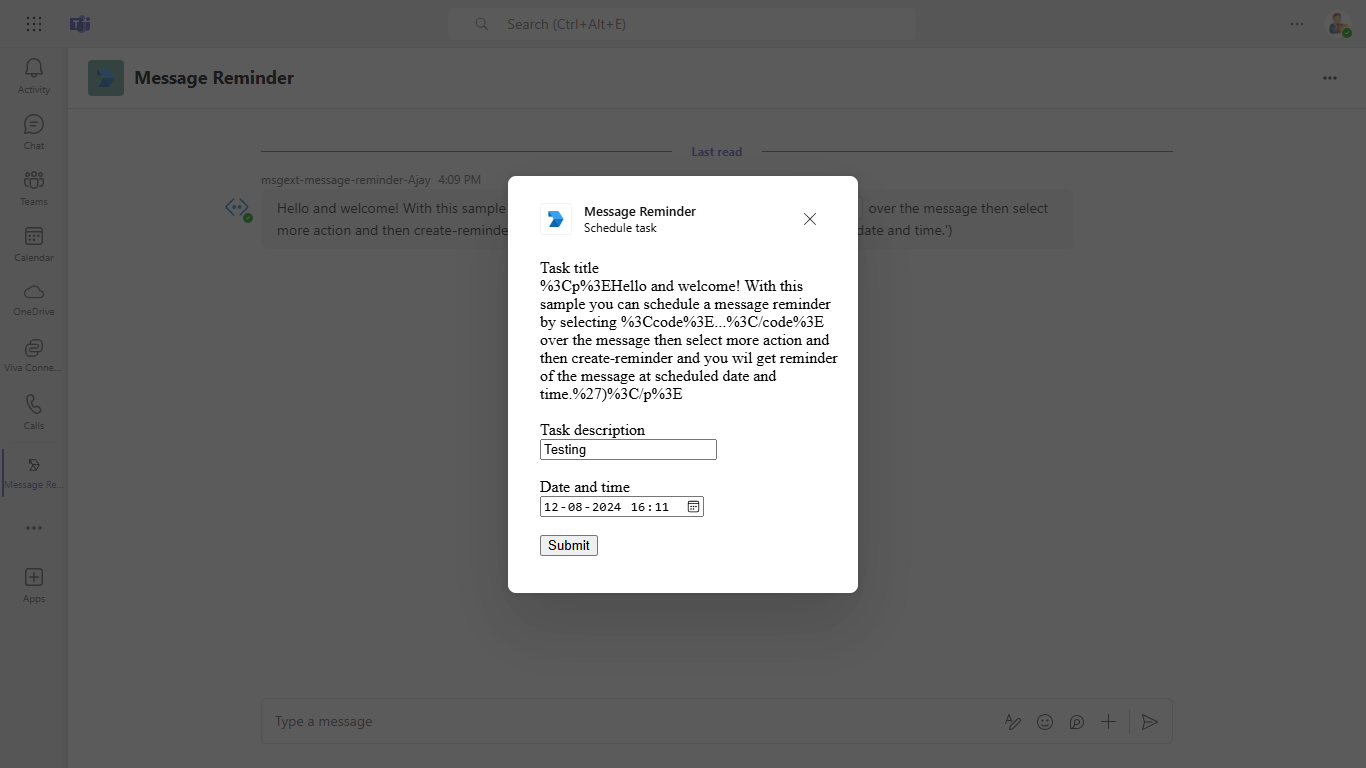| page_type | description | products | languages | extensions | urlFragment | ||||||||
|---|---|---|---|---|---|---|---|---|---|---|---|---|---|
sample |
This sample demonstrates a Node.js Messaging Extension that allows users to schedule tasks and receive reminder cards in Microsoft Teams. |
|
|
|
officedev-microsoft-teams-samples-msgext-message-reminder-nodejs |
This comprehensive Node.js sample illustrates how to create a Messaging Extension that enables users to schedule tasks from within Microsoft Teams, complete with reminder cards sent at the scheduled times. With straightforward setup and seamless integration, this extension enhances productivity by allowing users to efficiently manage their tasks and reminders.
Please find below demo manifest which is deployed on Microsoft Azure and you can try it yourself by uploading the app package (.zip file link below) to your teams and/or as a personal app. (Sideloading must be enabled for your tenant, see steps here).
Message reminder with messaging extension action: Manifest
- Microsoft Teams is installed and you have an account (not a guest account)
- NodeJS
- dev tunnel or ngrok latest version or equivalent tunneling solution
- M365 developer account or access to a Teams account with the appropriate permissions to install an app.
- Teams Toolkit for VS Code or TeamsFx CLI
The simplest way to run this sample in Teams is to use Teams Toolkit for Visual Studio Code.
- Ensure you have downloaded and installed Visual Studio Code
- Install the Teams Toolkit extension
- Select File > Open Folder in VS Code and choose this samples directory from the repo
- Using the extension, sign in with your Microsoft 365 account where you have permissions to upload custom apps
- Select Debug > Start Debugging or F5 to run the app in a Teams web client.
- In the browser that launches, select the Add button to install the app to Teams.
If you do not have permission to upload custom apps (sideloading), Teams Toolkit will recommend creating and using a Microsoft 365 Developer Program account - a free program to get your own dev environment sandbox that includes Teams.
-
Register a new application in the Microsoft Entra ID – App Registrations portal.
-
Setup for Bot
- In Azure portal, create a Azure Bot resource.
- Ensure that you've enabled the Teams Channel
- While registering the bot, use
https://<your_tunnel_domain>/api/messagesas the messaging endpoint. NOTE: When you create app registration, you will create an App ID and App password - make sure you keep these for later.
- Setup NGROK
-
Run ngrok - point to port 3978
ngrok http 3978 --host-header="localhost:3978"Alternatively, you can also use the
dev tunnels. Please follow Create and host a dev tunnel and host the tunnel with anonymous user access command as shown below:devtunnel host -p 3978 --allow-anonymous
-
Setup for code
- Clone the repository
git clone https://github.com/OfficeDev/Microsoft-Teams-Samples.git
- Update the
.envconfiguration for the bot to use theMicrosoftAppIdandMicrosoftAppPassword,BaseUrlwith application base url. For e.g., your ngrok or dev tunnels url. (Note the MicrosoftAppId is the AppId created in step 1 (Setup for Bot), the MicrosoftAppPassword is referred to as the "client secret" in step 1 (Setup for Bot) and you can always create a new client secret anytime.)
-
In the folder where repository is cloned navigate to
samples/bot-task-reminder/nodejs -
Install modules
npm install
-
Run your app
npm start
-
Setup Manifest for Teams
-
This step is specific to Teams.
- Edit the
manifest.jsoncontained in the ./appManifest folder to replace your Microsoft App Id (that was created when you registered your app registration earlier) everywhere you see the place holder string{{Microsoft-App-Id}}(depending on the scenario the Microsoft App Id may occur multiple times in themanifest.json) - Edit the
manifest.jsonforvalidDomainsand replace{{domain-name}}with base Url of your domain. E.g. if you are using ngrok it would behttps://1234.ngrok-free.appthen your domain-name will be1234.ngrok-free.appand if you are using dev tunnels then your domain will be like:12345.devtunnels.ms. - Zip up the contents of the
appManifestfolder to create amanifest.zip(Make sure that zip file does not contains any subfolder otherwise you will get error while uploading your .zip package)
- Edit the
-
Upload the manifest.zip to Teams (in the Apps view click "Upload a custom app")
- Go to Microsoft Teams. From the lower left corner, select Apps
- From the lower left corner, choose Upload a custom App
- Go to your project directory, the ./appManifest folder, select the zip folder, and choose Open.
- Select Add in the pop-up dialog box. Your app is uploaded to Teams.
Note: If you are facing any issue in your app, please uncomment this line and put your debugger for local debug.
- Personal scope scenario
Select
...over message to get actioncreate-reminderfor scheduling task.
Task module to schedule a task.
Reminder card of task at scheduled date and time.
- Team scope scenario Navigate to team where the app is installed
Select ... over message to get action create-reminder for scheduling task.
Task module to schedule a task.
Reminder card of task at scheduled date and time.






